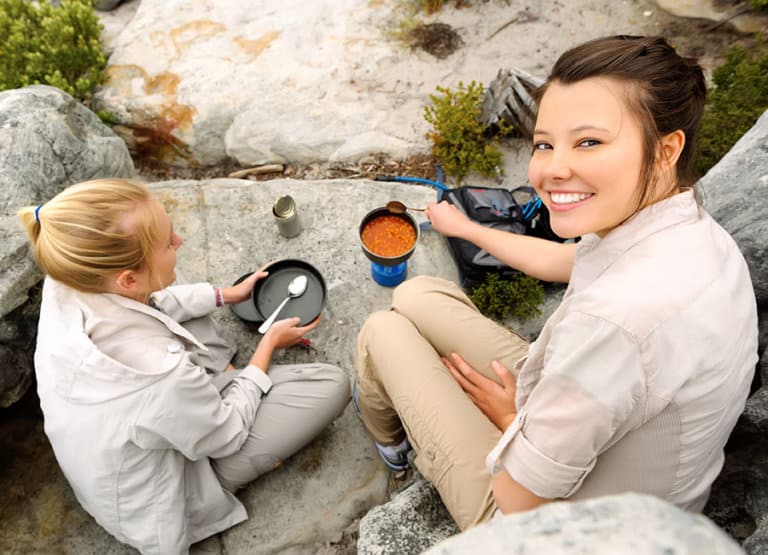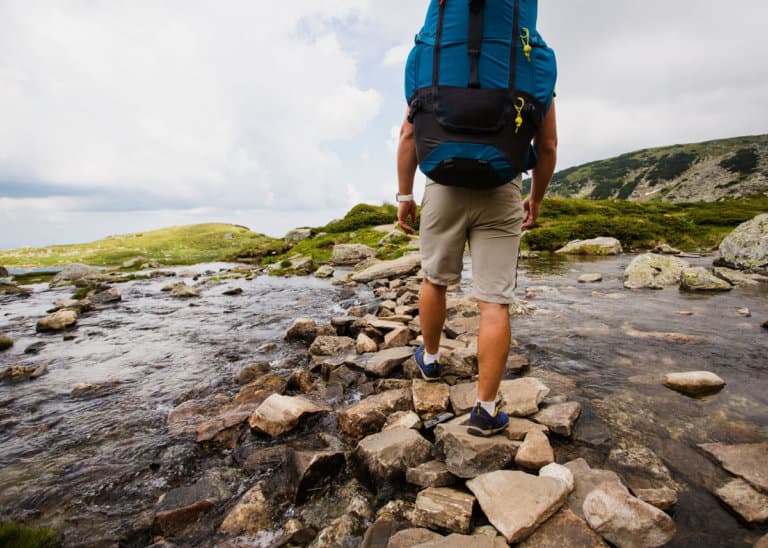How to Keep Food Cold While Camping (18 Chilly Tips & Gear)
Planning a camping trip and want to keep your food nice and cold? In this post, you’ll learn how to keep food cold while camping. I include 9 tips to keep your cooler cold for longer, 5 food safety tips, and 4 of the best camping coolers available.
Having cold camping food means that you’ll eat better – and stay healthier. Let’s get started!

How to Keep Food Cold While Camping
I love camping! I love the great outdoors, snacking and chatting around the campfire, and sleeping under the stars.
But without the right setup, it can be hard to keep enough food after a couple of days. The fun can go out of camping if all that’s left is a few tins of baked beans and some canned meat to live on. That or candy.
All it takes is some organization and forward planning! A goodcooler is a must. What type can vary considerably depending on your setup, but you need to have some kind of insulated box.
Here’s how to ensure that your cooler works at its best, and then I will go through the best coolers on the market for all budgets.

9 Tips to Keep Food Cold When Camping
How to ensure your cooler works at its best: Getting a good quality cooler is key to ensuring your perishables stay cold.
But there are many other factors you need to consider to maximize the cold time you have while you’re away.
1. Cool the cooler first
When most people put their food and ice in their cooler, the cooler is not cold. It is worth getting a bag of loose ice and throwing it into the cooler a few hours before you begin to pack.
Then you can throw the ice out just before you pack the cooler. That way the cooler is not starting out at room temperature but is cold. As a result, the food will stay as cold as it did in the fridge from the get-go.
2. Type of ice is key
The ice that you get from the local gas station is not the best option, although it is certainly the easiest and the most popular. This ice will melt quickly and will end up (before long) as a pool of water.
It is probably perfectly fine if you are just using this ice for drinks and have a well-insulated cooler but try to avoid using this ice for food because your food will end up either soggy, warm, or both.
3. Take 2 coolers
Relating to the previous point, it is probably wise to have two coolers, if you have space and the budget. Drinks in one cooler and food in the other. The benefits of this are numerous.
The drinks cooler is likely to have heavier traffic. This heavy traffic will mean that the cooler is regularly opened and closed, and warm air gets in as cold air goes out.
With two coolers, you can ensure that the food cooler is only opened when absolutely necessary while people can refresh their glasses whenever they wish. Everyone wins!
4. Start with frozen food
Not everything can be frozen. But if you freeze what can be frozen, then it will keep cool for longer and will cool the things that can’t be frozen for longer.
Here’s more: How long does ice last in a cooler?
5. Freeze your water
Fill any spare spaces in your cooler with frozen bottles of water. Unlike ice cubes, these water bottles will stay frozen for longer and therefore keep your food cooler!
As an added benefit, long after your drinks cooler has gone warm, you will have some cold water to drink.
There’s no harm in putting a couple of these bottles in the drinks cooler as well if you have the space; they will help everything stay cool for longer.
6. Pack the cooler tight
The more space there is for air to pass through your cooler, the more quickly your food will warm.
Make sure that every space is filled with either an ice pack or a frozen water bottle.
7. Pack the cooler right
There is a correct way and an incorrect way to pack a cooler.
- First, place a layer of ice block at the bottom of the cooler.
- Next place the meat (which is hopefully frozen).
- Then, if you have space, a layer more ice blocks.
- Then sealed and packaged items on the second layer, and then anything else on the top, more delicate items should remain on top. Your food should take up no more than 60% of the cooler’s storage space, especially if you wish to keep your food cold for more than 3 days. Then fill the rest of the space with ice.
Here are six safe ways to pack eggs for camping.
8. Keep your cooler out of the sun
Make sure that you keep your cooler out of the sun at all times and if needed, cover it with a tarp or blanket to further insulate it.
9. Use dry ice
Place dry ice on top of the food, ensuring that it is wrapped in newspaper to protect your icebox from damage.
Make sure you never touch dry ice directly with your hands, and only use dry ice if you can transport your cooler in the trunk or the back of your truck.
It gives off carbon dioxide gas which can be dangerous, so if you’re using dry ice store your cooler away from your tent and pets.
Check out this article for more tips about using dry ice in your cooler.

More reading: Guide to Thru-Hiking Food: Meals, Snacks and Tips
Cooler Boxes: The Coldest For Camping
So which cooler is best? It does end up coming down to your budget. You can easily spend hundreds on a cooler, and if you can afford to, and are going to make use of the cooler on a regular basis, I would certainly recommend that you do.
Buying a cooler from your local discount store is not going to give you a good result, because it is not going to be effectively insulated and sealed and you will very quickly have warm food on your hands. The following are my picks at a range of prices.
1. Yeti Tundra 65 Cooler
Capacity: 65 quarts
- Size: 12 x 2 x 5 inches
- Empty Weight: 35.1 lbs
- Check the current price on Amazon or Yeti
The Yeti is not only a highly insulated cooler that will keep your ice as ice for as long as possible, but it boasts to be bear-proof! (If you don’t fancy camping with a bear, here’s how to keep them away).
The Yeti has three inches of permafrost for insulation. The latches are incredibly high quality so they will resist breaking even with lots of weight.
Another benefit is that if you wish to experiment with the use of dry ice in your chilling, this cooler will resist the damage that would be caused to many other coolers by dry ice because it is resistant to Tundra-level conditions.
It also has the benefit of a dry goods rack for keeping your sandwiches from getting soggy!
2. Igloo Yukon Cold Locker Cooler
Capacity: 70 quarts
- Size: 36 x 20.7 x 20.3 inches
- Empty Weight: 25.8 lbs
- Check current price
The Igloo Yukon boasts ice retention for up to 7 days, using 2-3 inches of insulation and “Cool Riser Technology”.
User reviews back up this claim for ice retention for up to 8 days, which is very impressive. It is strong, durable, and made to last.
3. Pelican Elite 70 Quart Cooler
Capacity: 70 quarts
- Size: 36 x 20.3 x 21 inches
- Empty Weight: 38 lbs
- Check the current price on Amazon or Pelican
The Pelican Elite boasts a lifetime replacement guarantee and is made in the USA.
It has freezer-grade seals to ensure that no hot air seeps in and user reviews confirm that the ice keeps for approximately a week, so great for a longer camping trip.
It states it is overkill for a weekend camping trip due to the weight but this is probably the case for them all!
4. Coleman Extreme Cooler
Capacity: 70 quarts
- Size: 23 x 17.5 x 17.5 inches
- Empty Weight: 12.3 lbs
- Check the current price on Amazon or Walmart
This will leave much more in your budget than the first three coolers. It boasts five days of ice retention.
If you are more of an amateur camper, and not keen to spend too much but want a quality piece for a reasonable price, then this Coleman is a great bet. If you are looking for a cheaper option, this would be the best choice.
Which cooler will you choose? Ultimately, whatever your budget, you should be able to lengthen the life of your ice and keep your food cold for longer by following my tips above.
Please ensure that when camping, you are very careful with perishable food and do not take any risks.
Even if you do everything you can to keep things cool, if you are unsure about the coolness or freshness of your food, please do not risk eating something that is spoiled.
More reading: How to Choose (and Pack) the Best Camping Food
5 Food Safety Guidelines for Camping
Follow some simple food safety guidelines to ensure that you and your friends and family stay safe while you’re away. They are:
- Wash your hands regularly, and always before handling food
- Don’t cross-contaminate – use different utensils for preparing meat and vegetables, and store items so that meat juices do not run into vegetables and other foods
- Cook food properly so that it is heated through. Learn how to cook on a campfire.
- Check the use-by dates and do not eat food that has passed its use-by date
- Keep a thermometer in your cooler to ensure that the temperature remains below 40˚F
If you follow all this advice, you should have yourself a safe, enjoyable camping trip with a bit more than candy to get you through the last few days!
Planning a campfire? Check out our Ultimate Guide to Starting a Campfire (6 Ways)
Your Turn
How do you keep your food cold while camping? Please share your tips below!










